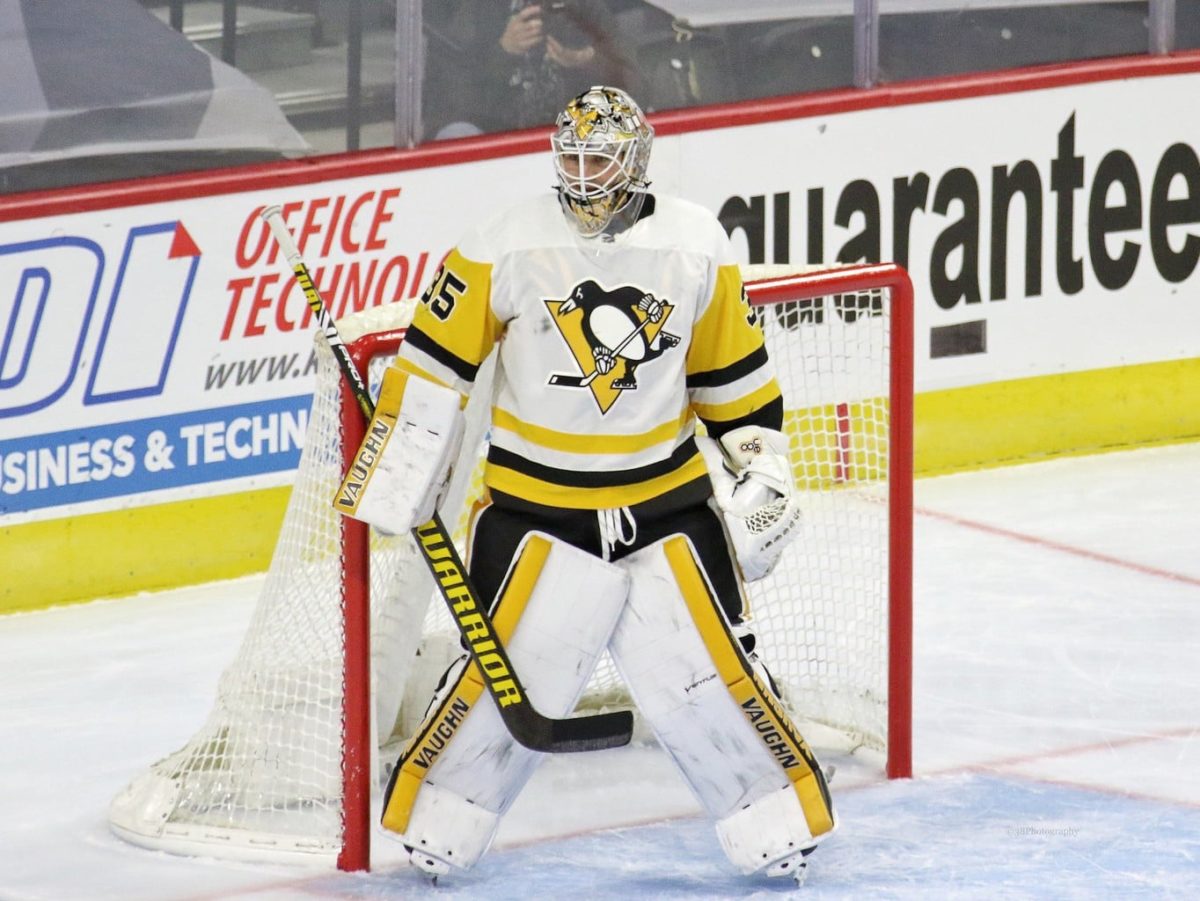If you take the NHL standings at face value, you might think that the Pittsburgh Penguins have had a predictable start to the 2021-22 season. Heading into the regular season, the Penguins knew they would hit the ice short-handed, with their franchise pillars in Sidney Crosby and Evgeni Malkin slated to recover from offseason surgery. However, that sells the narrative short with a slew of storylines emerging as the calendar turns to November. Let’s dig into a few statistics and storylines which defined Pittsburgh’s first month of the season and contemplate which trends are minor blips and which could continue through to the end of the year.
10 Penguins Stats and Storylines From First 14 Games
There has been no shortage of notable storylines to glean from Pittsburgh’s first 14 games of the season, and this list of 10 statistics and related storylines should act as a primer of the month that was. From an unfathomably sterile power play to an unusual suspect leading the team in points, this list has it all covered.
1. NHL’s Worst Power Play
There’s no sugar-coating it; Pittsburgh’s 8.7% conversion rate on the power play is abysmal. Every other team in the NHL has eclipsed the 10% mark at this point, and the Edmonton Oilers have scored over four times as many goals as the Penguins on the man-advantage (18 to 4). If that’s not cringe-worthy enough, Pittsburgh has also allowed the league’s third-most short-handed goals (2). When you’ve only scored two more goals than you’ve conceded when up a man, that’s not exactly an established recipe for success.

Surprisingly, they generate a decent number of chances on the power play (ninth in expected goals per-60), but the puck just isn’t hitting the back of the net. The lack of scoring personnel certainly figures in, but this goes beyond simple injury woes. Considering that last season’s Anaheim Ducks posted the worst power-play percentage in NHL history (8.94%), and it was still higher than Pittsburgh’s this season, I’d say this drought shouldn’t continue for much longer. Right?
2. Zucker-Rodrigues-Kapanen Line Dominating
Without Pittsburgh’s usual culprits, the team needed to find inspiration from elsewhere on the roster. Enter a trio of solid but unspectacular skaters who have combined to form one of the NHL’s best forward lines. In 99 minutes at five-on-five, the triumvirate of Jason Zucker, Evan Rodrigues, and Kasperi Kapanen has posted a 70% share (best in the NHL) of expected goals for (xGF%) which bests the Boston Bruins’ Perfection Line by more than five percentage points in second place.
They’ve also recorded the second-lowest rate of expected goals against per 60 minutes (xGA/60) and have yet to concede an actual goal when on the ice, outscoring their opposition 6-0 at 5v5. They’ve been extraordinarily dominant, and I’d keep the trio intact once Pittsburgh’s injured players return to full health to give the team a dependable depth unit.
3. Jake Guentzel Loves Drawing Penalties
For a Penguins team that has been used to deploying Crosby, Malkin, and Kris Letang on the top power-play unit for the better part of two decades, having players that excel at drawing penalties is an underrated benefit. This season, Jake Guentzel has been that nuisance by drawing eight total penalties in all situations (third in the NHL) and suffering under the seventh-highest rate of infractions against per 60 minutes at five-on-five. His deceptive speed and agility forces opposing defenses to respect him, opening up better opportunities for his linemates. What’s not to like?
4. Evan Rodrigues Leads Penguins in Scoring
Whoever had Rodrigues as the Penguins’ scoring leader through 14 games put your hands up. Now that we’ve identified the liars in the room, let’s look at what’s driven his success. He’s playing almost a minute more per game (13:04) at 5v5 than his previous career-high and has elevated his shot rate to nearly 10.5 per-60-minutes, nearly two more than his previous benchmark.
You May Also Like:
- Every NHL Team’s Longest-Tenured Player
- Every NHL Team’s Most Underrated Prospect
- 4 Penguins Who Will Not Return in 2024-25
- NHL Rumors: Canucks, Blackhawks, Maple Leafs, Penguins
- Jake Guentzel Confirms He Wanted to Stay With the Penguins
He’s also featured heavily on the power play (2:43 per game) and skated with more talented linemates as a result. He’s shooting nearly double his career rate of 8% (14.6% in 2021-22) and won’t see the same usage once Pittsburgh’s familiar faces return, but increased scoring depth is a welcome development.
5. Penguins’ Goalies Struggling Early
As a collective unit, Pittsburgh’s goalies have struggled to find their groove. Tristan Jarry and Casey DeSmith have combined to put up a porous .899 save percentage (SV%) in all situations, which leaves the Penguins 23rd in team SV% through the first month of play.

Looking closer, it’s clear that Jarry is not to blame. He’s flaunting a respectable .918 SV%, while DeSmith has allowed 14 goals in three games and submitted an atrocious .856 SV% in response. DeSmith has also allowed the fifth-most goals above expected per-60-minutes, occupying the same space as two goalies belonging to the Arizona Coyotes. You know, the historically awful Coyotes? Is backup net-minder a position that needs a trade upgrade?
6. Pettersson-Marino Pairing Among NHL’s Best Defensive Duos
Head coach Mike Sullivan is no stranger to juggling his forward lines and defensive pairings, but he’s found a reliable duo in Marcus Pettersson and John Marino. The two have experienced extensive success together this season, providing the Penguins with a sturdy pillar in a time of turmoil. Among defense pairs with at least 75 minutes played at 5v5, the Pettersson-Marino pair ranks 22nd in xGF% (56.1%), 13th in their on-ice share of shot attempts (56.8%), and Pittsburgh has outscored its opposition 5-2 with the two patrolling the blue line.
Although the pair drives play relatively well, their true impact lies on the defensive side of the puck, where the two allow the fewest shot-attempts on goal per-60-minutes (CA/60) and the second-lowest rate of expected goals against (xGA/60) among qualified defensive pairs. If the Penguins need to shutdown other primary scoring options, this resilient pairing is the first over the boards.
7. Penguins Playing Disciplined Hockey
Being heavily penalized is a direct route to stressing a team’s penalty kill units and gives opponents a much easier opportunity to score goals. Luckily for the Penguins, they’ve been among the most disciplined teams through the first month of the season. They only get called for an average of 6.7 penalty minutes per game, the second-lowest rate in the NHL. Pittsburgh’s sterling penalty kill (86.1% – seventh in the NHL) gives them some leeway if they do increase their infraction rate, but they’ve managed to consistently stay out of the box in the early going.
8. Pittsburgh’s Injuries Taking Their Toll
Long-term injuries to Pittsburgh’s most prominent players have wreaked havoc on the Penguins’ roster, forcing depth players to take on greater roles in the lineup as the team seeks its 16th straight playoff berth. NHL Injury Viz’s data shows Pittsburgh accumulated the second-most CHIP (Cap Hit of Injured Players) this season, behind only the Vegas Golden Knights.
Malkin (14 games), Crosby (12), and Bryan Rust (7) make up the vast majority of the CHIP total, and, unsurprisingly, the team has yet to resemble the Metropolitan Division winners of last season. The Penguins should be encouraged that both Crosby and Rust were featured in their last game against the Washington Capitals and that they might get on a roll sooner than later.
9. Eastern Conference Playoff Spot Slipping Away
With nearly 70 more games remaining on the schedule, declaring any team out of playoff contention this early is nonsensical. Yet, the Penguins are quickly losing ground on the automatic places, currently seven points adrift of the Metropolitan Division’s third-place team, the New York Rangers.
Now, seven points aren’t impossible to make up throughout a long season, nor do the Penguins even need that many to climb into an Eastern Conference wildcard place, but things are testy. They boast a points percentage of .500, which ties them for 13th in the Eastern Conference with the Buffalo Sabres, not the company Pittsburgh is used to keeping. Crosby’s return should boost their fortunes, and it’s entirely likely that they occupy an automatic place come mid-December.
10. Drew O’Connor’s Efficient Offensive Production
Although Drew O’Connor has been demoted to Pittsburgh’s American Hockey League (AHL) affiliate in Wilkes-Barre/Scranton, he showed that he belongs in the NHL in his brief promotion to start the season. Despite his limited usage, the 23-year-old winger tallied five points in 12 games and scored at a top-six rate in the process. He produced 2.56 points-per-60, which was good enough for 42nd among NHL skaters to have played at least 100 minutes at 5v5. He played less than 10 even-strength minutes each night, but he made the most of his opportunity and gave the Penguins a welcome spark in the lineup.
Will These Penguins Statistical Trends Continue?
It can’t be harped on enough but 14 games – though not insignificant – is still a very small sample size that can be held hostage by volatile puck luck. Some of the negative numbers on this list should regress to something resembling league average, and a few hot starts will surely fizzle out. What will the second month of the season bring for the Penguins?
Data courtesy of Evolving Hockey, Hockey Reference, MoneyPuck, and Natural Stat Trick. Statistics accurate as of November 15th.
